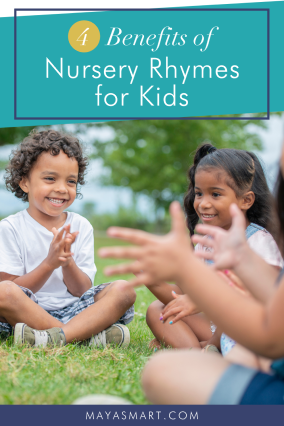By Maya Payne Smart
More and more students enter school with no knowledge of classic nursery rhymes, primary school teachers report. Some traditional poems like Baa Baa Black Sheep passed from generation to generation for centuries, but they hold markedly less appeal for today’s parents. Indeed, many parents admit not recalling the nursery rhymes of their youth, let alone teaching them to their kids. And this has some educators, researchers, and early childhood experts worried.
Heightened scrutiny of the lyrics and origins of traditional songs plus competition from flashier child entertainment options contribute to the decline. Some of the classic tunes have undeniably racist roots, and conscious parents don’t want to pass their offensive themes and imagery on to a new generation. Other rhymes just feel dated and of uncertain value to younger parents. Going on about an old woman who lived in a shoe seems no more enriching than bopping along to Baby Shark.
But nursery rhyme defenders insist that the vast repertoire of traditional songs (offensive titles excluded) present unparalleled opportunities to foster sought-after early literacy skills, easily, enjoyably, and affordably. I’m inclined to agree. Here’s a rundown of the top reasons to add nursery rhymes—classic, remixed, or brand new—to your daily parenting routines.
Brain Development
Professor Usha Goswami, director of the University of Cambridge’s Centre for Neuroscience in Education, says four key caregiver behaviors help babies acquire language:
- making eye contact
- speaking in exaggerated, sing-song tones
- responsiveness to the infants’ actions, movements, and verbalizations
- taking turns in “conversation” (even before kids can truly talk).
Nursery rhymes incorporate all four behaviors and therefore play a vital role in children’s earliest development. When parents gaze at a baby, gently grasp her big toe, sing this little piggy went to market, then pause for a coo or babble in response, they are sending communicative, brain-building signals that even a newborn can recognize and learn from.
The regular cadence, plus the rhymes’ rise and fall, provide “the perfect rhythmic template for the developing brain,” Goswami says. When sung, the traditional tunes move air molecules and create waves of sound pressure at rates that align well with the way brain cells in the auditory cortex move, she told The Times Educational Supplement. The deliberate, rhythmically regular speech exaggerates the signal in ways that help the developing brain convert sound into neural signals and make sense of language.
Word Learning
Baby language proceeds from grunts to coos to babbles, often not arriving at anything resembling recognizable speech until a child is ten months or older. But evidence suggests infants understand their first word (often their own name) as young as four months old. The median vocabulary size at 16 months is 55 words and jumps to ten times that by 30 months. And the talking, singing, or reading of caregivers introduced each and every one.
Toddlers typically hear thousands of words a day, which includes any nursery rhymes their parents sing. If it weren’t for repeated recitations of Little Miss Muffett, I wouldn’t have learned the words tuffet, curds, and whey for years, if ever. But long before kindergarten, I picked up this unusual vocabulary and held a mental picture of a little girl seated on a stool eating something like cottage cheese.
Research confirms it wasn’t only the repetition that aided my word learning, but the power of the rhyme itself. Rhymes encourage kids to anticipate upcoming words and that active curiosity about what’s coming next makes new vocabulary more memorable, hypothesizes researcher Kirsten Read. The building anticipation and extra predictability of a rhyming word at the end of a stanza may heighten kids’ attention and thereby help the new words stick.
Phonological Awareness
As adults, it’s easy to look at a word like cat, see its three letters, and associate them with three distinct sounds. But that’s a learned perception. In speech, the /c/, /a/, and /t/ sounds in cat are all blurred together. Kids have to learn to discern where one sound ends and the next one begins.
Nursery rhymes support future reading by heightening kids’ sensitivity to the syllables and the separate beginning, middle and ending sounds within words. The stress patterns of classics like Jack and Jill went up the hill help children learn about rhymes, an important phonological dimension. And the alliteration in a rhyme like Peter Piper Picked a Peck of Pickled Peppers accentuates the /p/ sound and helps it stand out from surrounding sounds, a finer-grained level of sound sensitivity.
Fine Motor Skills
Kids need to develop the tiny muscles in their hands and fingers to hold a crayon, pen, or pencil and learn to write. Parents can take a cue from children’s librarians and preschool teachers and use “fingerplays”—songs and rhymes acted out with hands and fingers alone. From hand-clapping to the tune of Pat-A-Cake with a baby to the more delicate pinching movements and wrist turns of the Itsy Bitsy Spider crawling up the water spout, these classic interactive rhymes boost kids’ fine motor skills and eye-hand coordination.
See this great video demo from Ms. Melissa, a children’s librarian with the Austin Public Library.
Did you learn nursery rhymes as a kid? Will you carry on the tradition?
Pin Me for Reference :



